Click on images to enlarge

a dense colony of this species (Photo: Sheldon Navie)
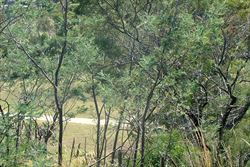
habit (Photo: Sheldon Navie)
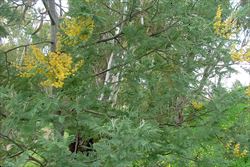
habit in flower (Photo: Sheldon Navie)
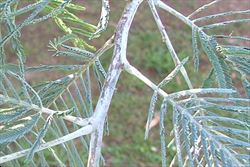
young branches and foliage tips covered in a whitish powdery bloom (Photo: Sheldon Navie)

the large twice-compound leaves which are bluish-green or somewhat silvery in colour (Photo: Sheldon Navie)

leaves with numerous pairs of branchlets, each containing many pairs of tiny leaflets (Photo: Greg Jordan)
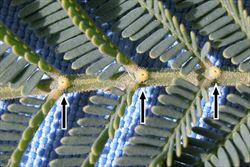
close-up of a leaf showing the small raised glands, at the junction of each pair of branchlets (Photo: Greg Jordan)
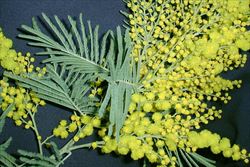
large compound flower clusters (Photo: Trevor James)
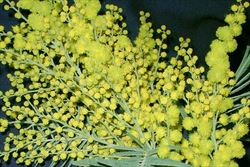
numerous small globular flower clusters arranged into elongated compound clusters (Photo: Trevor James)
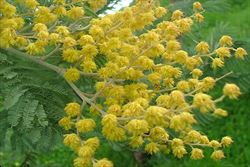
close-up of the small globular flower clusters and the whitish-coloured flower stalks (Photo: Sheldon Navie)

close-up of seeds with small fleshy arils (Photo: Steve Hurst at USDA PLANTS Database)
Scientific Name
Acacia dealbata Link subsp. dealbata
Synonyms
Acacia dealbata LinkAcacia dealbata Link var. dealbataAcacia decurrens Willd. forma mollis (Lindl.) Benth.Acacia decurrens Willd. var. dealbata (Link) F. Muell. ex MaidenAcacia decurrens Willd. var. mollis Lindl.Acacia decurrens Willd. var. mollissima E. MiegeAcacia derwentiana A.M. GrayAcacia puberula Dehnh.Racosperma dealbatum (Link) PedleyRacosperma dealbatum (Link) Pedley subsp. dealbatum
Family
Fabaceae: sub-family Mimosoideae (New South Wales)Leguminosae (South Australia)Mimosaceae (Queensland, the ACT, Victoria, Tasmania, Western Australia and the Northern Territory)
Common Names
black wattle, blue wattle, mimosa, silver wattle, Sydney black wattle, Tasmania mimosa
Origin
Silver wattle (Acacia dealbata subsp. dealbata) has a relatively widespread natural distribution in south-eastern Australia. It is native to most of eastern New South Wales, the ACT and most of Victoria (in mainland Australia it is most common near the Great Dividing Range from the Ben Lomond Range in northern New South Wales to the Grampians in western Victoria). It is also widespread and common throughout Tasmania.
Note: Another form of this species (i.e. Acacia dealbata subsp. subalpina), which is often smaller in stature with smaller leaves and leaflets, grows mainly at higher altitudes in south-eastern New South Wales, the ACT and north-eastern Victoria (e.g. in the Snowy Mountains). However, Acacia dealbata subsp. subalpina has not become naturalised outside its native range and will not be mentioned any further here.
Cultivation
Silver Wattle (Acacia dealbata subsp. dealbata) is cultivated in many parts of Australia, as well as overseas, and can often be seen growing as an ornamental in inhabited areas.
Several cultivars have been developed that differ form the description given here, the most common in Australia being a prostrate ground-covering form called Acacia dealbata 'Kambah Karpet'. There is also a variety with weeping stems (which is sometimes called Acacia dealbata var. pendula) and numerous other varieties that were developed in southern France, but these are mostly grown overseas.
Naturalised Distribution
Naturalised in south-western Western Australia, south-eastern South Australia and on Norfolk Island. In Western Australia it is naturalised in the the coastal and sub-coastal districts between Perth and Albany. In South Australia it is particularly common near Adelaide and is also present in the extreme south-east of the state.
This species has also become naturalised overseas in southern Africa, New Zealand, southern India, southern Europe, and south-western USA (i.e. California).
Habitat
Grows naturally in open woodlands, dry sclerophyll forests and wet forests at altitudes usually ranging from 350-1000 metres in many parts of south-eastern Australia. Within these areas in grows in deep gullies, on slopes, on high plateaus, on creekbanks and near swamp margins.
Silver wattle (Acacia dealbata subsp. dealbata) has become naturalised on stony slopes, along creekbanks and on roadsides in South Australia and Western Australia.
In New Zealand it grows in waste places and along dry riverbeds, in South Africa it invades grasslands, roadsides and watercourses, and in California it grows in disturbed sites and along roadsides.
Habit
A large bushy shrub or spreading tree usually growing 1.5-10 m tall, but occasionally reaching up to 30 m in height.
Distinguishing Features
- a large shrub or tree with twice-compound silvery-grey or bluish-green leaves.
- its young branches and immature fruit have a whitish-coloured powdery or waxy coating that gives them a frosty appearance.
- its hariy main leaf stalk has a small raised gland at the junction of each pair of leaf branchlets.
- its yellow or golden-yellow flowers are borne in small globular clusters that are arranged into larger elongated compound clusters.
- its fruit is an elongated and flattened pod (20-115 mm long).
Seedling
The seedlings have two small and narrow undivided seed-leaves (i.e. cotyledons). The first true-leaf is usually once-compound, with a few pairs of leaflets (i.e. pinnate), while the second true-leaf is usually twice-compound (i.e. bipinnate), with a single pair of branchlets (i.e. pinnae).
Stems and Leaves
The bark of this species is mostly smooth and either grey, greyish-brown, brown or dark brown in colour. However, older trunks may become deeply fissured. Younger branches are rounded or slightly angular with ridges towards their tips. These branches are usually finely hairy and conspicuously bluish-green (i.e. glaucous) or whitish in colour due to the presence of a powdery substance (i.e. they are pruinose). The young foliage-tips are white, whitish-yellow or cream-coloured and densely covered in fine hairs (i.e velvety-tomentose).
The leaves are twice-compound (i.e. bipinnate) and usually somewhat bluish-grey or silvery-green in colour (i.e. they are slightly to very glaucous). These leaves (6-17 cm long) are alternately arranged along the stems and have a short hairy leaf stalk (i.e. petiole) that is 1 to 15 mm long. The extension of this stalk (i.e. rachis), which bears numerous (10-30) pairs of leaf branchlets (i.e. pinnae), is 3-17 cm long (usually 5-10 cm long). It is finely hairy and bears a small raised structure (i.e. gland) at the junction of the each of the pairs of branchlets (i.e. pinnae). The leaf branchlets (15-55 mm long) each bear numerous (14-68) pairs of small, narrowly oblong to linear leaflets (i.e. pinnules). These leaflets (1.5-6 mm long and 0.4-1 mm wide) are very crowded and have rounded or pointed tips (i.e. obtuse to acute apices). Their upper surfaces are mostly hairless (i.e. glabrous), while their margins and lower surfaces are usually finely hairy (i.e. pubescent).
Flowers and Fruit
The small yellow or golden-yellow flowers are very fluffy in appearance due to the presence of numerous stamens. These flowers have five relatively inconspicuous petals and sepals and are densely arranged into small globular clusters (4-7.5 mm across), each containing 22-42 flowers. The small globular flower clusters are borne on short stalks (i.e. peduncles) 2-6 mm long that are finely hairy and usually whitish-grey in colour. These globular flower clusters are alternately arranged along a small branch emanating from the forks (i.e. axils) of the leaves, or occasionally borne at the tip of the stem. The branches are often somewhat zig-zagged in nature and may or may not be branched (i.e. they form axiallry or terminal racemes or panicles). Flowering generally occurs during late winter and spring (i.e. from July to November).
The fruit is an elongated and somewhat flattened pod (20-115 mm long and 6-14 mm wide). These pods are not, or only slightly, constricted between some or all of the seeds and are either straight or slightly curved. They are bluish-green (i.e. glaucous) or covered in a whitish powdery substance (i.e. pruinose) when young and generally turn greyish-brown or purplish-brown in colour as they mature. Fruit are normally present during late spring and summer (i.e. mostly from November to January, but sometimes through to March). Each pod contains several seeds (about 4 mm long) that have a small fleshy structure (i.e. aril) attached to them.
Reproduction and Dispersal
Reproduction of silver wattle (Acacia dealbata subsp. dealbata) is mainly by its long-lived seeds. However, this species is also known to produce numerous suckers when its roots are damaged.
Seeds may be dispersed short distances by ants that collect them and transport them to their nests. The pods, each containing several seeds, may be spread by wind and water. The seeds may also be dispersed in dumped garden waste and contaminated soil.
Environmental Impact
Silver wattle (Acacia dealbata subsp. dealbata) is widely cultivated in Australia and has become a garden escape beyond its native range in Western Australia and South Australia. Its seeds germinate readily after fire and it can form dense thickets.
In Western Australia it grows in jarrah forest and karri forest at the Porongorups and is also found along roadsides between Perth and Albany. It is considered to be a common environmental weed in the Adelaide region in South Australia, where it is reported to invade native bushland.
Legislation
Silver wattle (Acacia dealbata subsp. dealbata) is not declared or considered noxious by any state or territory government in Australia.
Management
For information on the management of this species see the following resources:
- the Woody Weeds Information Pamphlet on the Environmental Weeds Action Network (EWAN) website at http://members.iinet.net.au/~ewan/.
- Moore and Wheeler (2002), Southern Weeds and their Control, pp. 134-140.
Similar Species
Silver wattle (Acacia dealbata subsp. dealbata) may be confused with several other native wattles (Acacia spp.) including black wattle (Acacia mearnsii), Sydney green wattle (Acacia decurrens), green wattle (Acacia irrorata), northern silver wattle (Acacia leucoclada), Bodalla silver wattle (Acacia silvestris), dwarf silver wattle (Acacia nanodealbata), Cootamundra wattle (Acacia baileyana) and Karri wattle (Acacia pentadenia). These species can be distinguished by the following differences:
- silver wattle (Acacia dealbata subsp. dealbata) has young branches and foliage tips that are finely hairy and whitish-green or whitish-yellow in colour (i.e. pruinose). Its silvery-grey leaves have numerous (10-30) pairs of hairy branchlets (i.e. pinnae). These leaves are shortly stalked (i.e. petiolate) and there is usually a small raised structure (i.e. gland) near the top of this leaf stalk (i.e. petiole). There are also similar glands at the junction of the each of the pairs of branchlets (i.e. jugary glands). The leaflets are relatively small (1.5-6 mm long) and usually quite elongated in shape. Its flowers are yellow or golden yellow and borne in small globular clusters, which are arranged into larger elongated compound clusters (i.e. racemes or panicles). The pods are relatively large (20-115 mm long and 6-14 mm wide).
- black wattle (Acacia mearnsii) has young branches and foliage tips that are finely hairy and yellow or greenish-yellow in colour (i.e. not pruinose). Its dark green leaves have numerous (7-31) pairs of hairy branchlets (i.e. pinnae). These leaves are shortly stalked (i.e. petiolate) and there is usually a small raised structure (i.e. gland) near the top of this leaf stalk (i.e. petiole). There are also similar glands at the junction of the each of the pairs of branchlets (i.e. jugary glands), and also between some or all pairs of branchlets (i.e. interjugary glands). The leaflets are quite small (1-3.5 mm long) and usually not particularly elongated in shape. Its flowers are pale yellow or cream-coloured and borne in small globular clusters, which are arranged into larger elongated compound clusters (i.e. racemes or panicles). The pods are relatively large (30-150 mm long and 4-8 mm wide).
- Sydney green wattle (Acacia decurrens) has young branches with conspicuous flanges and foliage tips that are mostly hairless and yellowish in colour (i.e. not pruinose). Its dark green leaves have several to numerous (3-13) pairs of hairless branchlets (i.e. pinnae). These leaves are shortly stalked (i.e. petiolate) and there is usually a small raised structure (i.e. gland) near the top of this leaf stalk (i.e. petiole). There are also similar glands at the junction of the each of the pairs of branchlets (i.e. jugary glands). The leaflets are quite large (5-15 mm long) and very narrow. Its flowers are yellow or golden yellow and borne in small globular clusters, which are arranged into larger elongated compound clusters (i.e. racemes or panicles). The pods are relatively large (20-105 mm long and 4-9 mm wide).
- green wattle (Acacia irrorata) has young branches and foliage tips that are finely hairy and yellow, greenish yellow or orange in colour (i.e. not pruinose). Its dark green leaves have numerous (5-26) pairs of hairy branchlets (i.e. pinnae). These leaves are shortly stalked (i.e. petiolate) and there is no small raised structure (i.e. gland) near the top of this leaf stalk (i.e. petiole). There are small glands at the junction of the some of the pairs of branchlets (i.e. jugary glands). The leaflets are relatively small (2-5 mm long) and usually quite elongated in shape. Its flowers are pale yellow or cream-coloured and borne in small globular clusters, which are arranged into larger elongated compound clusters (i.e. racemes or panicles). The pods are relatively large (20-120 mm long and 5-12 mm wide).
- northern silver wattle (Acacia leucoclada) has young branches and foliage tips that are finely hairy and silvery or whitish in colour (i.e. pruinose). Its silvery or green leaves have numerous (5-18) pairs of hairy branchlets (i.e. pinnae). These leaves are shortly stalked (i.e. petiolate) and there is sometimes a small raised structure (i.e. gland) near the top of this leaf stalk (i.e. petiole). There are also similar glands at the junction of some or all of the pairs of branchlets (i.e. jugary glands), and also between several of the pairs of branchlets (i.e. interjugary glands). The leaflets are relatively small (1-6 mm long) and usually quite elongated in shape. Its flowers are yellow or golden yellow and borne in small globular clusters, which are arranged into larger elongated compound clusters (i.e. racemes or panicles). The pods are relatively large (30-120 mm long and 4-12 mm wide).
- Bodalla silver wattle (Acacia silvestris) has young branches and foliage tips that are finely hairy and whitish, grey or yellow in colour (but not pruinose). Its green or silvery-green leaves have numerous (5-18) pairs of mostly hairless branchlets (i.e. pinnae). These leaves are shortly stalked (i.e. petiolate) and there are sometimes one or more small raised structures (i.e. glands) near the top of this leaf stalk (i.e. petiole). There are also similar glands at the junction of all of the pairs of branchlets (i.e. jugary glands), and also one or more glands between each of the pairs of branchlets (i.e. interjugary glands). The leaflets are relatively large (3-11 mm long) and usually quite elongated in shape. Its flowers are yellow and borne in small globular clusters, which are arranged into larger elongated compound clusters (i.e. racemes or panicles). The pods are relatively large (40-155 mm long and 6-10 mm wide).
- dwarf silver wattle (Acacia nanodealbata) has young branches and foliage tips that are finely hairy and yellow or greenish-yellow in colour (i.e. not pruinose). Its dark green leaves have numerous (6-26) pairs of mostly hairless branchlets (i.e. pinnae). These leaves are shortly stalked (i.e. petiolate) and there is sometimes a small raised structure (i.e. gland) near the top of this leaf stalk (i.e. petiole). There are also prominent glands at the junction of all of the pairs of branchlets (i.e. jugary glands). The leaflets are very small (1-2.5 mm long) and usually not particularly elongated in shape. Its flowers are golden yellow and borne in small globular clusters, which are arranged into larger elongated compound clusters (i.e. racemes or panicles). The pods are relatively large (30-85 mm long and 9-20 mm wide).
- Cootamundra wattle (Acacia baileyana) has young branches and foliage tips that are hairless or slightly hairy and bluish-green or occasionally purplish in colour (i.e. pruinose). Its silvery-grey leaves have only a few (2-6) pairs of branchlets (i.e. pinnae). These leaves are almost stalkless (i.e. sub-sessile) and the lowermost pair of branchlets (i.e. pinnae) are angled backwards (i.e. reflexed). There are small raised structures (i.e. glands) at the junction of the upper few pairs of branchlets (i.e. jugary glands). The leaflets are relatively small (3-8 mm long) and somewhat elongated in shape. Its flowers are yellow or golden yellow and borne in small globular clusters, which are arranged into larger elongated compound clusters (i.e. racemes). The pods are relatively large (30-120 mm long and 8-15 mm wide).
- Karri wattle (Acacia pentadenia) has young branches and foliage tips that are hairless and greenish in colour (i.e. not pruinose). Its dark green leaves have only a few (2-5) pairs of branchlets (i.e. pinnae). These leaves are almost stalkless (i.e. sub-sessile) and the lowermost pair of branchlets (i.e. pinnae) are very small. There are small raised structures (i.e. glands) near the junctions of each of the pairs of branchlets (i.e. jugary glands). The leaflets are relatively small (3-6 mm long) and somewhat elongated in shape. Its flowers are pale yellow or cream-coloured and borne in small globular clusters, with only a few (2-4) of these clusters being arranged into short compound clusters. The pods are relatively small (20-50 mm long and only 3-4 mm wide).
Hybrids of silver wattle (Acacia dealbata subsp. dealbata) and Cootamundra wattle (Acacia baileyana) are known to occur, particularly in Vicotria, and they are also considered to be weeds. Such hybrids are intermediate between the two species and can be distinguished from silver wattle (Acacia dealbata subsp. dealbata) by having fewer (i.e. 6-12) pairs of branchlets, with the lowermost pair of branchlets usually being angled slightly backwards (i.e. reflexed).
Note: This page only covers those species that have been reported to be commonly confused with silver wattle (Acacia dealbata subsp. dealbata). For a more in-depth key to all of the wattle (Acacia spp.) present in Australia, see the Wattle: Acacias of Australia CD-ROM or Flora of Australia, Volumes 11A and 11B.

